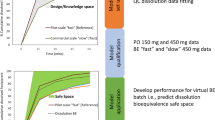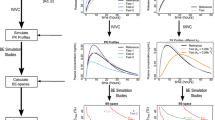Abstract
Classical methods employing pharmacokinetic data to calculate zero-order release rates for sustained release products require that a constant-rate drug delivery system must have a duration which is exactly equal to the desired dosage interval. This traditional approach fails to establish the minimum acceptable duration and also fails to provide any flexibility in the formulation goal. While it does calculate one pair of duration and dose values, there are infinite pairs of values capable of maintaining the desired plasma concentrations using the selected dosing interval. In the current method, computer simulations are used to establish the boundary conditions within which any pair of duration and dose values will maintain the desired levels when administered on the chosen dosing interval. By comparing the boundary conditions for every subject in a group, a single set of conditions which would work for the entire group can be selected. These final limits represent the broadest specifications for zero-order drug delivery system design for that particular drug combined with the plasma concentration goals and the desired dosing interval. The method is illustrated using theophylline pharmacokinetics.
Similar content being viewed by others
REFERENCES
P. G. Welling and M. R. Dobrinska. In J. R. Robinson (ed.), Sustained and Controlled Release Drug Delivery Systems, Marcel Dekker, New York, 1978, pp. 631–716.
E. Nelson. J. Am. Pharm. Assoc. Sci. Ed. 46:572–578 (1957).
M. Rowland and A. H. Beckett. J. Pharm. Pharmacol. 16 (Suppl.):156T (1964).
J. R. Robinson and S. P. Erikson. J. Pharm. Sci. 55:1254–1262 (1966).
M. G. Dobrinska and P. G. Welling. J. Pharm. Sci. 64:1728–1729 (1975).
K. C. Kwan. In J. R. Robinson (ed.), Sustained and Controlled Release Drug Delivery Systems, Marcel Dekker, New York, 1978, pp. 595–629.
J. D. Rogers and K. C. Kwan. In J. Urquhart (ed.), Controlled-Release Pharmaceuticals, American Pharmaceutical Associations, Washington, D.C., 1981, pp. 95–119.
R. G. Weigand and J. D. Tailor. Biochem. Pharmacol. 3:256–261 (1960).
E. Kruger-Theimer and S. P. Eriksen. J. Pharm. Sci. 55:1249–1254 (1966).
J. R. Robinson and S. P. Eriksen. J. Pharm. Sci. 59:1796–1800 (1970).
R. E. Notari. Biopharmaceutics and Clinical Pharmacokinetics, an Introduction, 4th ed., Marcel Dekker, New York, 1987, pp. 109, 191–208, 387–392.
J. G. Wagner. Fundamentals of Clinical Pharmacokinetics, Drug Intelligence, Hamilton, Ill., 1975, pp. 136–144.
T. Y. Lee and R. E. Notari. Pharm. Res. 4:311–316 (1987).
P. M. Loughnan, D. S. Sitar, R. I. Ogilvie, A. Eisen, Z. Fox, and A. H. Neims. J. Pediat. 5:874–879 (1976).
H. S. Kaumeier, O. H. Kehrhahn, G. Neugebauer, D. Schuppan, J. A. Schwarz, and A. H. Staib. Arzneim-Forsch. 34:92–95 (1984).
P. Bolme, M. Eriksson, G. Lonnerholm, and L. Paalzow. Acta Pharmacol. Toxicol. 51:401–406 (1982).
F. W. H. M. Merkus and L. Hendeles (eds.). Sustained Release Theophylline: A Biopharmaceutical Challenge of a Clinical Need, Exerpta Medica, Amsterdam, 1983.
P. G. Welling, L. L. Lyons, W. A. Craig, and G. A. Trachta. Clin. Pharmacol. Ther. 17:475–481 (1975).
D. L. Spangler, D. D. Kalof, F. L. Bloom, and H. J. Wittig. Ann. Allergy 40:6–13 (1978).
E. R. Barnhart. Physicians' Desk Reference, 40th ed., Medical Economics, Oradell, N.J., 1987, p. 1048.
G. S. Avery (ed.). Drug Treatment, Principles and Practice of Clinical Pharmacology and Therapeutics, Publishing Sciences Group, Acton, Mass., 1976, p. 571.
Author information
Authors and Affiliations
Rights and permissions
About this article
Cite this article
Lee, TY., Notari, R.E. Computer-Aided Dosage Form Design. II. Methods for Defining a Zero-Order Sustained-Release Delivery System of Maximum Formulating Flexibility. Pharm Res 4, 385–391 (1987). https://doi.org/10.1023/A:1016478127409
Issue Date:
DOI: https://doi.org/10.1023/A:1016478127409




